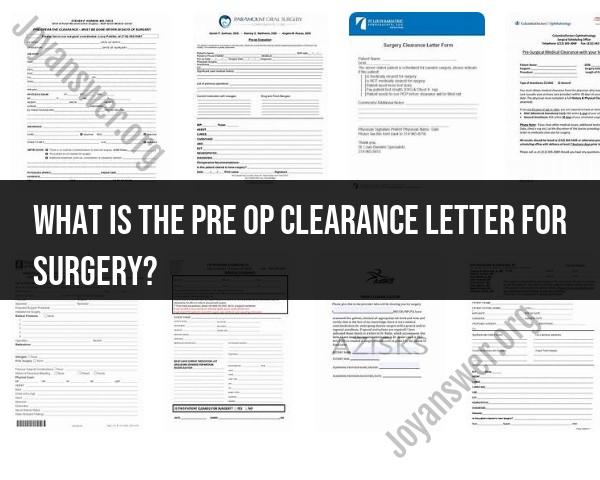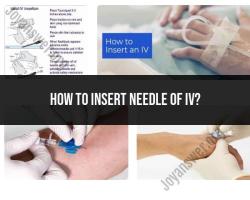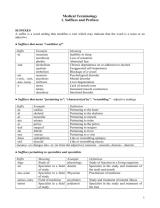What is the pre op clearance letter for surgery?
A pre-operative (pre-op) clearance letter is a medical document issued by a healthcare provider, typically a primary care physician or specialist, that plays a crucial role in the surgical process. This letter serves to assess and confirm a patient's fitness for a planned surgical procedure and is an essential step in ensuring the safety and success of the operation. Here is what you should know about the pre-op clearance letter:
1. Medical Evaluation: Before certain surgical procedures, especially major surgeries or those involving anesthesia, it's standard practice for the surgeon to require a thorough medical evaluation of the patient. This evaluation helps assess the patient's overall health and identify any underlying medical conditions that might affect the surgery.
2. Purpose: The pre-op clearance letter serves several purposes:
- It ensures that the patient is in the best possible condition for surgery and minimizes risks.
- It identifies any pre-existing medical conditions, such as heart disease, diabetes, hypertension, or allergies, that the surgeon and anesthesia team need to be aware of.
- It allows the healthcare provider to recommend specific pre-operative interventions, like medication adjustments, tests, or consultations with specialists, if needed.
- It helps determine the patient's ability to tolerate anesthesia and the surgical stress.
3. Components: A pre-op clearance letter typically includes the following components:
- A summary of the patient's medical history and current health status.
- A list of any pre-existing medical conditions, medications, and allergies.
- Recommendations for pre-operative interventions, if necessary.
- Confirmation of the patient's fitness for surgery.
- The healthcare provider's contact information and signature.
4. Communication: The pre-op clearance letter serves as a means of communication between the patient's primary healthcare provider, the surgeon, and the anesthesia team. It ensures that all involved parties are aware of the patient's medical background and can make informed decisions regarding the surgical procedure.
5. Timing: The pre-op clearance letter is usually obtained in the weeks or days leading up to the surgery, but the timing may vary depending on the complexity of the procedure and the patient's medical condition.
6. Post-Operative Care: After surgery, the patient's healthcare provider may also issue post-operative instructions and recommendations for follow-up care to ensure a smooth recovery.
It's important to note that not all surgical procedures require pre-op clearance, and the necessity of the clearance letter depends on the type of surgery and the patient's medical history. However, for complex or major surgeries, the pre-op clearance letter is a standard part of the surgical process to help ensure the patient's safety and well-being throughout the operation and recovery.
Pre-Op Clearance Letter for Surgery: Importance and Process
A pre-op clearance letter for surgery is a document from a healthcare provider that states that a patient is medically fit to undergo surgery. The letter is typically required by the surgeon or hospital before the surgery can be scheduled.
The purpose of a pre-op clearance letter is to:
- Identify any underlying medical conditions that could increase the patient's risk of complications during or after surgery
- Assess the patient's overall health and fitness for surgery
- Provide the surgeon with important information about the patient's medical history and current medications
The Role of Pre-Operative Evaluation and Clearance
Pre-operative evaluation and clearance is an important process that helps to ensure the safety of patients undergoing surgery. By identifying and managing any underlying medical conditions, pre-operative evaluation can help to reduce the risk of complications during and after surgery.
The pre-operative evaluation process typically includes a medical history and physical examination, as well as any necessary laboratory tests or imaging studies. The healthcare provider will also review the patient's current medications and discuss any potential risks and benefits of surgery.
Medical Examinations and Documentation for Clearances
The specific medical examinations and documentation required for a pre-op clearance letter will vary depending on the type of surgery being performed. However, some common examinations and documentation may include:
- Medical history and physical examination
- Laboratory tests, such as blood tests and urine tests
- Imaging studies, such as X-rays, CT scans, and MRIs
- Anesthesia evaluation
- Clearance from any other relevant healthcare providers, such as a cardiologist or pulmonologist
Collaborating with Healthcare Providers for Clearance
It is important for patients to collaborate with their healthcare providers to obtain a pre-op clearance letter. Patients should provide their healthcare providers with a complete and accurate medical history, as well as a list of all current medications. Patients should also be prepared to answer any questions that their healthcare providers may have about their health.
Preparing for Surgery with a Clearance Letter
Once a patient has obtained a pre-op clearance letter, they should provide it to their surgeon or hospital. The surgeon or hospital may review the letter to ensure that the patient is medically fit to undergo surgery.
Patients should also follow any specific instructions that their healthcare providers give them in preparation for surgery. For example, patients may be asked to fast for a certain period of time before surgery or to stop taking certain medications.
By following the steps above, patients can help to ensure that they are prepared for surgery and that they have the best possible chance of a successful outcome.













